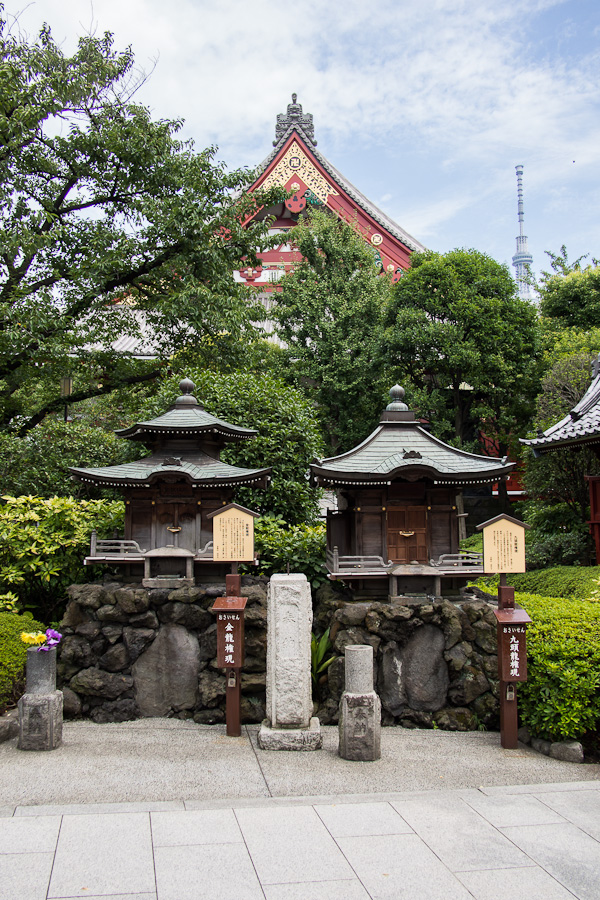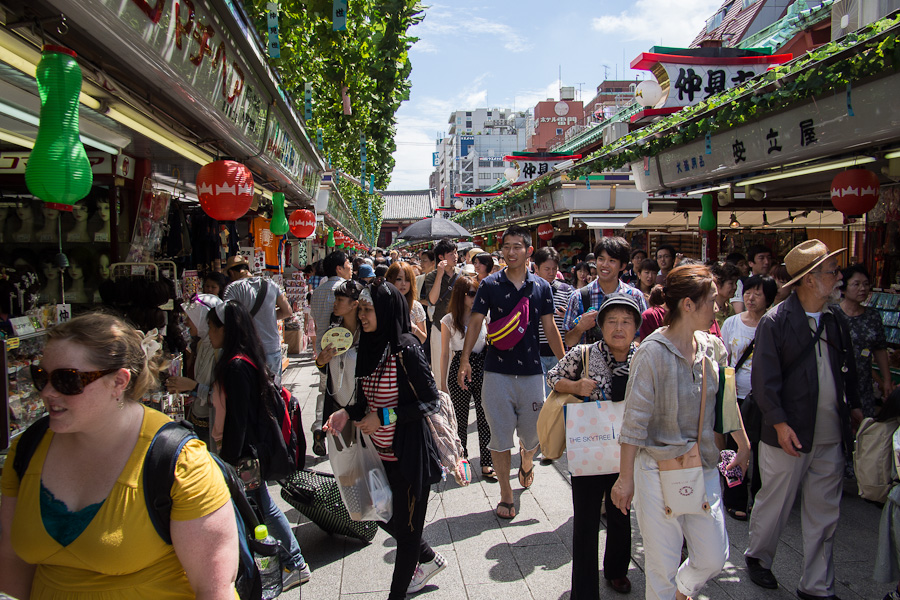Perhaps our time there was misspent or we lack the necessary perspective, but we spent a lot of time in Asakusa, and it did not really manage to lift the veil of the present and reveal the past, to speak in hyperbole. This is not to say that Asakusa isn’t different from the rest of the city, nor that a visit to the area would be a mistake, quite the contrary, but it is not the trip back though the mists of time you may expect.
Asakusa is pronounced “Asaksa” – in Japanese the “u” is generally dropped or severely elided in most words. Thus, “Tsukiji” becomes “Skiji” phonetically.
If our time in Tokyo has shown me anything, it’s that Tokyo is more like its own small country inside of Japan. Everything in Tokyo is furiously modern, even the most traditional shops and streets are a modern take on the original, and Asakusa does offer a small respite from this. On the other side of the city from frantic Shibuya and futuristic Shinjuku and trendy Harajuku, Asakusa is a little quieter, closes a little earlier and is just a bit more calm. During the day, like the rest of Tokyo, Asakusa is packed to the gills with tourists, both foreign and local and it’s easy to lose sight of the small shops that line the arcades when you are in the swarm of humanity that crowds the lanes, but this quickly fades as night falls and people seem to go just about anywhere else.

I think, perhaps, for the Tokyoite or long-term traveller who has been living in Tokyo for a while, Asakusa might seem more different from the rest of Tokyo, even quaint. There are more paper lanterns, more small shops with wooden sliding doors, shops close early and of course there is Senso-ji temple. The temple grounds are expansive, and the temple and pagoda are massive. Obviously ancient, these buildings are sacred and very popular, lending them an air of authenticity and antiquity that is, like so much of Tokyo, seamlessly blended with the modern. Throngs of tourists (and faithful) gape at traditional monks while stands set up in the temple courtyard sell grilled corn, fried squid and shaved ice. If you look towards the river you can see the towering Tokyo Sky Tree behind the temple gates. Asakusa’s latest addition reminds everyone that the modernity of the city can’t be denied forever, not even in Asakusa. After dark the juxtaposition is even more striking, as the Sky Tree becomes an enormous light show that runs through the night.
For a more unadulterated experience, the best time to visit the temple is early in the morning, preferably before 7 a.m. Tokyo is a sleepy city that is late to wake, and if you are up early, not only will you beat some of the heat and humidity, but you’ll have the temple all to yourself. At 6:45 a.m. the only souls there are a few dog walkers and the devout, clapping at the shrines to attract the attention of the Gods.
Radiating out from the temple complex are little shopping arcades selling all and sundry goods, everything from toothpaste to traditional paper fans, all of which is colorful and adorned with cartoon mascots, kanji and all of the Japanese ephemera that dazzles our western sensibilities. Simply walking through the crowds, smelling the incense and frying taiyaki (small doughy confections shaped like fish) is a wonderful experience.



The arcades are an assault on the senses during the day, but if you want to shop or eat in Asakusa, you have to get your timing right. Shops open late, usually around 10, and close early. Walking through the district after 8 p.m. is an eerie experience, with few lights on and most shops shut tight for the night. The only sounds to guide you through the area are the infrequent shrieks from the amusement park hidden away behind walls next to the temple gardens.
Staying in Asakusa was the right choice, and if we were to return to Tokyo I would want to stay there again. Prices were lower and there was easy access to both of Tokyo’s major subway companies. Getting around the city using Asakusa as a base was easy and fast. Apart from that, walking to the subway early in the morning, or returning late at night, was always refreshing. In the morning the occasional dog barking, and awakening cicadas buzzing contentedly made me feel ready for the assault of Tokyo and its unrelenting humanity and humidity. After a long day, wandering through quiet alleys and the abandoned temple at night, there was almost no sound, the distant hum of Tokyo traffic all but gone. The buzz of crowds was replaced by the clink of glass as shop owners sat down to dinner with their families, and the creak of the giant paper lanterns swaying in the breeze.

Any trip to Tokyo should include a stop in Asakusa, if for nothing else to be awed by Senso-ji temple and the myriad shopping stalls in every direction. But don’t expect to be swept away by history or feel transported to another place, because that isn’t what Tokyo is about. Tokyo is aggressively homogenous and accessible, which makes visiting easy, but at the cost of just a little bit of soul. I think, however, that if there is soul to be found in Tokyo, Asakusa is a good place to start.
That shot you have of Asakusa is probably the emptiest I’ve ever seen it. Seeing those pictures really took me back… the Skytree wasn’t done yet when I first went there.
Well, it was before seven in the morning (and it was already steamy out!). Like I said, the early morning is easily the best time to go, and is easy to do when you are suffering massive jet lag.
They are promoting the heck out of the Skytree in Tokyo and beyond. We saw signs for it as far away as Nikko and they were selling Skytree sweat rags on the river tour we took from Hama-rikyu. I guess they are proud of it.
I’ve contemplated visiting Japan and hope to do so at some point, so if I spend time in Tokyo, I’ll be sure to visit (if not stay), in Asakusa. Thanks for the tip about pronunciation too, previously I would have always pronounced Tsukiji with a “u” sound.
No worries, the locals are all really excited to give language lessons! When they learn that we can say things like “you’re welcome” and “excuse me” they get really excited and try to teach us all kinds of words. We have really found the Japanese to be very open and interested in travelers, which has been really nice. Asakusa is a great place to stay for sure, lots to look at and some interesting food too.
It was just fascinating to visit Senso ji Temple and taking a stroll of the Nakamise Dori shopping arcade. Yes, it does get very crowded as the day wears on. And the night shot of the sky tree as the background is fabulous!!
Thanks! Sometimes the shots just jump right out at you 🙂 It’s a really interesting place and the shopping arcade had a lot of neat things to gawk at. We enjoyed it, despite the oppressive heat and crushing crowds.